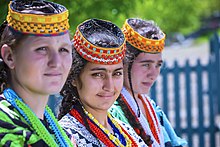കലാഷ് ജനത
 Kalash girls photographed in April 2016 | |
| Total population | |
|---|---|
| c. 7,000 (incl. Urchuniwar people)[1][2] | |
| Regions with significant populations | |
| Chitral District, Pakistan | |
| Languages | |
| Kalasha, Khowar | |
| Religion | |
| Majority Ancient Hinduism[3][i][4] / Animism;[5][6][7] Minority Islam[8] | |
| ബന്ധപ്പെട്ട വംശീയ ഗണങ്ങൾ | |
| Nuristanis, other Indo-Aryan peoples |
പാകിസ്ഥാനിലെ ഏറ്റവും ചെറിയ വംശീയ ന്യുനപക്ഷ സമൂഹം ആണ് കലാഷികൾ. പാകിസ്താനിലെ വെള്ളക്കാർ എന്നാണ് ഇവർ അറിയപ്പെടുന്നത്. ഇവരുടെ ജനസംഖ്യ എന്ന് പറയുന്നത് വെറും 5000 മാത്രമാണ്. പാകിസ്ഥാനിലെ ഖൈബർ-പഖ്തൂൺഖ്വ പ്രവിശ്യയിലെ ചിത്രാൽ ജില്ലയിൽ താമസിക്കുന്ന കലാഷി ജനത ഇന്തോ - ഗ്രീക്ക് വംശം ആണ്.[9][ii] അലക്സാണ്ടർ ചക്രവർത്തി ഇന്ത്യ ആക്രമിച്ചപ്പോൾ ഇവിടെ വന്ന ഗ്രീക്കുകാരും ഇന്ത്യക്കാരുടെയും സമ്മിശ്ര ജനതയാണ് ഇവർ. അതു കൊണ്ട് തന്നെ ഇവരെ കാണാൻ പശ്ചാത്യ നാടുകളിലെ ആളുകളെ പോലെയാണ്. അത് കൊണ്ടാണ് ഇവരെ പാകിസ്താനിലെ വെള്ളക്കാർ എന്നറിയപെടുന്നത്. കലശ എന്ന ഭാഷയാണ് ഇവർ സംസാരിക്കുന്നത്. ഈ ഭാഷ ഇന്തോ-ആര്യൻ ഭാഷ കുടുംബത്തിലെ ദാർദിക് ഉപഗ്രൂപ്പിൽ ഉൾപ്പെടുന്ന ഒരു ഭാഷയാണ്.[10][11][iii] ഇവരുടെ വസ്ത്രധാരണം വളരെ അധികം പ്രേത്യേകത ഉള്ളതാണ് കൗറി ഷെല്ലുകൾ കൊണ്ട് അലങ്കരിച്ച കറുത്ത വസ്ത്രമാണ് സ്ത്രീകൾ ധരിക്കുന്നത്. പുരുഷന്മാർ പാകിസ്താനി കമീസ് ധരിക്കുന്നു. കുട്ടികൾ നാലു വയസ്സിനു ശേഷം മുതിർന്നവരുടെ വസ്ത്രം ധരിക്കുന്നു. ഇവരുടെ വിശ്വാസ കഥകൾ ഗ്രീക്കുമായി ബന്ധപെട്ടു കിടക്കുമ്പോൾ ആചാരങ്ങൾ വേദകാല ജനങ്ങളേടെതുമായി സാമ്യം ഉള്ളതാണ്. ഇവരുടെ ദൈവങ്ങൾക്ക് ഹിന്ദുമത ദേവതകളുമായി സാമ്യം ഉണ്ട്. ഇന്ദ്രൻ ഇന്ദർ വരെന്ദർ എന്ന പേരിലും മഹാദേവൻ മഹാനന്ദിയൊ എന്ന പേരിലും അറിയപെടുന്നു. ഇന്നത്തെ പാകിസ്താനിലെ പടിഞ്ഞാറൻ ഭാഗങ്ങളിലും ഹിന്ദുകുഷ് പർവത നിരകളിലും ആണ് ഈ ജനവിഭാഗം ഉള്ളത്.
അവലംബം[തിരുത്തുക]
കുറിപ്പുകൾ[തിരുത്തുക]
- ↑ The Kalasha are a unique people living in just three valleys near Chitral, Pakistan, the capital of North-West Frontier Province, which borders Afghanistan. Unlike their neighbors in the Hindu Kush Mountains on both the Afghani and Pakistani sides of the border the Kalasha have not converted to Islam. During the mid-20th century a few Kalasha villages in Pakistan were forcibly converted to this dominant religion, but the people fought the conversion and, once official pressure was removed, the vast majority continued to practice their own religion.
- ↑ The Kalasha are a unique people living in just three valleys near Chitral, Pakistan, the capital of North-West Frontier Province, which borders Afghanistan ... However, it is much more likely, given their Indo-Aryan language, that the religion of the Kalasha is much more closely aligned to the Hinduism of their Indian neighbors that to the religion of Alexander the Great and his armies.[9]
- ↑ Nowadays, the term "Dardic" is used as an areal term that refers to a number of Indo-Aryan languages, without claiming anything specific about their mutual relatedness.[11]
- ↑ "Languages of Hindukush". University of Chitral. Archived from the original on 2022-02-09. Retrieved 24 April 2022.
- ↑ ഉദ്ധരിച്ചതിൽ പിഴവ്: അസാധുവായ
<ref>ടാഗ്;Ayub-Mezzavilla-etal-2015എന്ന പേരിലെ അവലംബങ്ങൾക്ക് എഴുത്തൊന്നും നൽകിയിട്ടില്ല. - ↑ 3.0 3.1 West, Barbara A. (19 May 2010). Encyclopedia of the Peoples of Asia and Oceania (in ഇംഗ്ലീഷ്). Infobase Publishing. p. 357. ISBN 9781438119137.
- ↑ Bezhan, Frud (19 April 2017). "Pakistan's forgotten pagans get their due" (in ഇംഗ്ലീഷ്). Radio Free Europe/Radio Liberty. Retrieved 11 July 2017.
About half of the Kalash practice a form of ancient Hinduism infused with old pagan and animist beliefs.
- ↑ ഉദ്ധരിച്ചതിൽ പിഴവ്: അസാധുവായ
<ref>ടാഗ്;Searle-2013എന്ന പേരിലെ അവലംബങ്ങൾക്ക് എഴുത്തൊന്നും നൽകിയിട്ടില്ല. - ↑ ഉദ്ധരിച്ചതിൽ പിഴവ്: അസാധുവായ
<ref>ടാഗ്;Camerapix-1998എന്ന പേരിലെ അവലംബങ്ങൾക്ക് എഴുത്തൊന്നും നൽകിയിട്ടില്ല. - ↑ ഉദ്ധരിച്ചതിൽ പിഴവ്: അസാധുവായ
<ref>ടാഗ്;Sheehan-1993എന്ന പേരിലെ അവലംബങ്ങൾക്ക് എഴുത്തൊന്നും നൽകിയിട്ടില്ല. - ↑ ഉദ്ധരിച്ചതിൽ പിഴവ്: അസാധുവായ
<ref>ടാഗ്;Ahmed-1986എന്ന പേരിലെ അവലംബങ്ങൾക്ക് എഴുത്തൊന്നും നൽകിയിട്ടില്ല. - ↑ 9.0 9.1 West, Barbara A. (19 May 2010). Encyclopedia of the Peoples of Asia and Oceania (in ഇംഗ്ലീഷ്). Infobase Publishing. p. 357. ISBN 9781438119137.
- ↑ Kaw, M. K. (2004). Kashmir and It's People: Studies in the Evolution of Kashmiri Society (in ഇംഗ്ലീഷ്). APH Publishing. p. 295. ISBN 978-81-7648-537-1.
The term Dardic is stated to be only a geographical convention and not a linguistic expression.
- ↑ 11.0 11.1 Verbeke, Saartje (2017-11-20). Argument structure in Kashmiri: Form and function of pronominal suffixation (in ഇംഗ്ലീഷ്). BRILL. p. 2. ISBN 978-90-04-34678-9.
